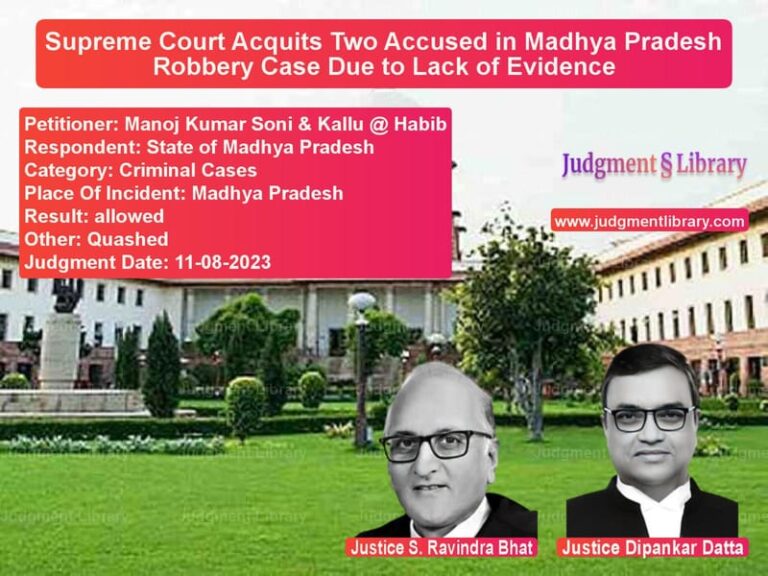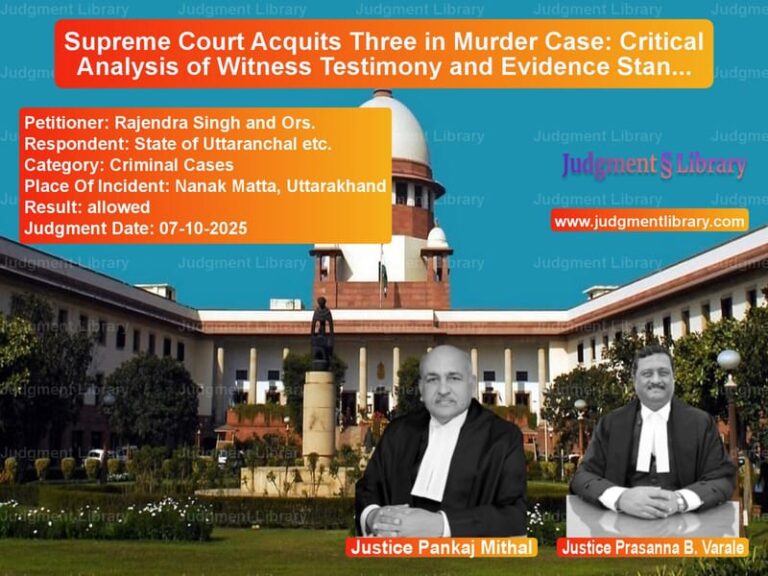Supreme Court Upholds Murder Conviction in Rajendra Singh vs. State of Uttar Pradesh
The Supreme Court of India, in the case of Rajendra Singh vs. State of Uttar Pradesh, upheld the conviction of the appellant under Section 302 of the Indian Penal Code (IPC). The case involved the murder of Satyapal Singh Chauhan, who was shot at close range by the accused. Initially acquitted by the trial court, Rajendra Singh was later convicted by the High Court, prompting the present appeal before the Supreme Court.
Background of the Case
The appellant, Rajendra Singh, was accused of shooting Satyapal Singh Chauhan on December 1, 1994. The prosecution alleged that Singh fired a revolver at close range, causing fatal injuries. The trial court acquitted the appellant, citing lack of sufficient evidence, but the High Court reversed this decision, convicting Singh under Section 302 IPC and Sections 25/27 of the Arms Act.
Key Legal Issues
- Whether the High Court was justified in reversing the acquittal and convicting the appellant.
- Whether the prosecution provided sufficient evidence to establish guilt beyond a reasonable doubt.
- Whether the trial court’s reasoning in acquitting the appellant was flawed.
- Whether the appellant had completed the mandatory period of his sentence and was eligible for remission.
Arguments by the Appellant
- The trial court had rightly acquitted the appellant, finding the evidence insufficient.
- The High Court erred in convicting the appellant without adequate legal grounds.
- The case was based primarily on circumstantial evidence.
- The appellant had already served more than 14 years of his sentence and was entitled to remission.
Arguments by the State (Respondent)
- The prosecution had proven beyond a reasonable doubt that the appellant was responsible for the murder.
- The High Court’s decision was based on a careful re-evaluation of the evidence.
- There was no plausible reason to interfere with the conviction.
- The case met all the legal standards required for upholding the guilty verdict.
Supreme Court’s Observations
The Supreme Court carefully examined the evidence and upheld the High Court’s findings. The key observations included:
- “Having scanned the evidence and keeping in view the fact that it is a case of reversal of acquittal, we are inclined to concur with the reasoning and the conclusion arrived at by the High Court.”
- “The prosecution was able to prove the case against the appellant beyond reasonable doubt.”
- “The High Court rightly held that it was the appellant and no one else who fired a bullet from his revolver within a short range to Satyapal Singh, which caused his death.”
- “This finding of the High Court is based on an appreciation of evidence, which was well within its jurisdiction to do in its first appellate jurisdiction.”
Final Judgment
The Supreme Court dismissed the appeal and upheld the conviction. However, it directed the State to consider the appellant’s case for remission:
- The appellant had served more than 14 years in jail, making him eligible for remission under the Criminal Procedure Code (Cr.P.C.).
- The Jail Authorities were directed to forward his application for remission to the competent State authority.
- The competent authority was instructed to review and pass an appropriate order within three months.
Implications of the Judgment
The ruling has several significant legal implications:
- Reaffirmation of High Court’s Authority: The judgment highlights that the High Court can reverse an acquittal if justified by the evidence.
- Judicial Review in Criminal Appeals: The Supreme Court upheld the principle that appellate courts must carefully evaluate evidence before overturning trial court decisions.
- Consideration for Remission: The Court balanced justice with rehabilitation by allowing the appellant to seek remission after serving a substantial portion of his sentence.
Conclusion
The Supreme Court’s ruling in Rajendra Singh vs. State of Uttar Pradesh reinforces the judiciary’s commitment to ensuring that convictions are based on strong evidence. While upholding the conviction, the Court also considered the appellant’s eligibility for remission, emphasizing the role of judicial discretion in balancing punishment with rehabilitation.
Petitioner Name: Rajendra Singh.Respondent Name: State of Uttar Pradesh.Judgment By: Justice Abhay Manohar Sapre, Justice Indu Malhotra.Place Of Incident: Uttar Pradesh.Judgment Date: 23-10-2018.
Don’t miss out on the full details! Download the complete judgment in PDF format below and gain valuable insights instantly!
Download Judgment: Rajendra Singh vs State of Uttar Prade Supreme Court of India Judgment Dated 23-10-2018.pdf
Direct Downlaod Judgment: Direct downlaod this Judgment
See all petitions in Murder Cases
See all petitions in Bail and Anticipatory Bail
See all petitions in Judicial Review
See all petitions in Judgment by Abhay Manohar Sapre
See all petitions in Judgment by Indu Malhotra
See all petitions in dismissed
See all petitions in supreme court of India judgments October 2018
See all petitions in 2018 judgments
See all posts in Criminal Cases Category
See all allowed petitions in Criminal Cases Category
See all Dismissed petitions in Criminal Cases Category
See all partially allowed petitions in Criminal Cases Category







